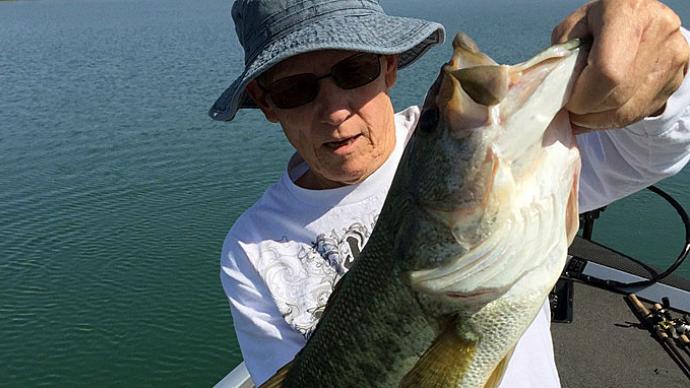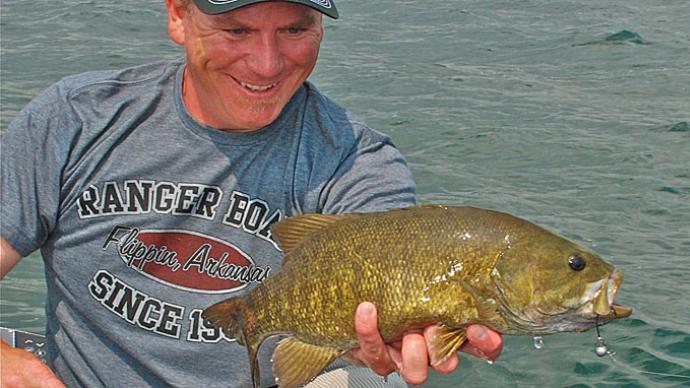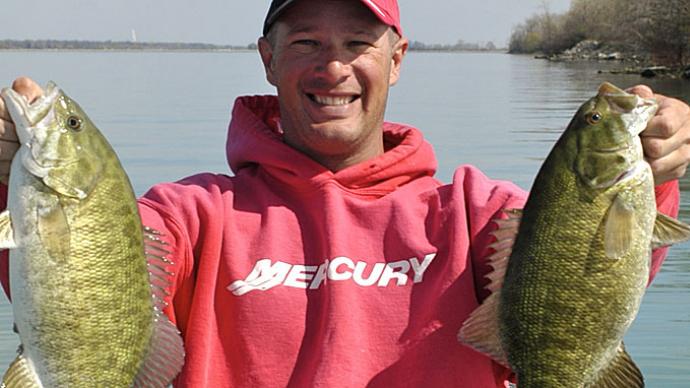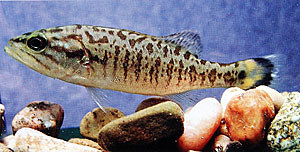
There's a bite. Quick, set the hook! Look, that fish is fierce, jumping way out of the water. It's a bass, a smallmouth bass! Keep a tight line or it will throw your hook. It jumps again and again, this time with head shaking, water splashing, an even higher leap. If this sounds like fun, then "heads up"...you too can grow this exciting bass in a small or large pond.
In the last three articles, I discussed habitat requirements, spawning needs, and development of hatchling smallmouth bass. Here, I will tell you what it takes to grow fingerlings to larger sizes and produce nice-size juvenile bass.
Setting the Stage
It has been stated in Pond Boss magazine that "The static condition of most ponds makes smallmouth bass a poor choice for stocking in small systems. Many ponds in the upper Midwest support a remnant population of smallmouth but seldom have sufficient water quality and forage base to flourish." I have never found this statement to be totally true, especially my experiences with smallmouth in local small ponds ... as long as they are the only bass present. The exceptions occur when smallies are combined with largemouth bass or some other prolific predator. Then, smallmouth are only able to maintain remnant populations that do not flourish.
My experiences with smallmouth in ponds indicate smallies do best in good water quality and slightly clearer water than largemouth bass normally thrive in. Even a small pond as far south as Phoenix, Arizona has a thriving population of smallies. This pond has hot tub temperature water in summer but the water is good quality, fairly clear water. The higher water temperatures into the low to mid 90's range does not seem to be a problem for raising smallies, providing water is most often clearer than 20-24" and of good quality with ample dissolved oxygen. That particular pond has a well designed water filtration system with water being moved through a well thought-out artificial wetland system.

For these and other good reasons, I don't think the better smallie pond should be fertilized. Fertilizing causes overall lower water transparency and results in a greater chance of short term oxygen losses due to periodic plankton bloom crashes. A dense or moderate bloom with rich, green water also inhibits visual feeding smallies. Inhibited feeding results in less frequent feeding and slower growth.
The single-most important thing to do to produce fingerling smallies is to eliminate largemouth bass. I have never seen an instance where smallies produce juvenile bass when combined with reproducing largemouth bass. Largemouth numbers always dominate. When combined with largemouths, smallies must be periodically restocked to maintain numbers.
Even though smallies build nests at slightly lower water temperatures and several days before largemouths build nests, smallies do not get good spawns because largemouths are behaviorally dominant and force smallies off newly excavated prime nest sites. Largemouths then use the new nest for their brood. If smallies ever manage to have a successful spawn, the highly visible and vulnerable black-colored fry are quickly consumed by young, aggressive, always hungry largemouths.
Smallmouth bass evolved primarily as an efficient stream dwelling species, whereas largemouth developed genetically as primarily a still or static water species (Near et.al. 2003). "These two species are primarily adapted for widely different habitat types and conditions and just don't mix well. Largemouths have instinctive advantages and the upper hand in pond or still water habitats. I think there are probably some unknown subtle, behavioral factors why the largemouth bass always out compete smallies in the pond setting.
Preferred Habitat
How does habitat for fingerling smallies differ from sub-adults compared to full grown fish?
Research shows foraging 1" to 3" smallies are more productive in cobble habitats than vegetation. The authors of one study concluded fingerling smallies were more vulnerable to predation in vegetated areas compared to cobble, rocky habitats that are common in streams. This no doubt relates back to development of smallies where they first evolved in stream habitats.
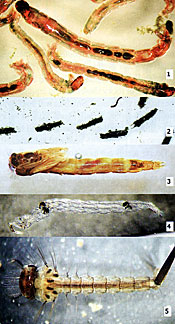
I have found the pond habitat most beneficial for encouraging fingerling recruitment is usually similar to that for the juvenile and adult smallies. The better smallie ponds have riprap or large rock-lined shorelines and/or breakwater areas extending several feet below the waterline. Riprap and breakwaters protect the shoreline from bank zone erosion and enhance habitat for fingerling smallies. Small and larger fingerlings prefer to use microhabitats where rock crevices are present.
Other common good refuge areas are coarse, woody debris or some areas of loosely spaced underwater vegetation. Clean, uncluttered shorelines result in poor percentage survival of young bass.
Observations indicate larger smallies are not quite as aggressive toward their own 1"-3" sizes compared to their aggressiveness toward other soft rayed forage fish and crayfish. Small to moderate amounts of shallow rocky cover mixed with some coarse woody cover and small amounts of submerged or emergent plants provide enough habitat for young bass to grow and survive and to compensate for natural mortality. Amounts of submerged weeds greater than 10-20% of the shoreline often result in overabundant smallies and slower overall growth rates.
If annual spawns do not regularly occur in your pond, then periodically restocking a few fingerlings or juvenile smallies will keep the population viable to include several year classes.
Most scientific reports consider young smallies as habitat and food specialists and fewer authors consider them generalists (Pert, Orth & Sabo 2002). One study considered young smallies to have an exceptional ability to take advantage of underutilized food and habitat resources. This results in smallies minimizing interactions with other fish while benefiting from available food.
Competition among other species of fish seems to be a very important item when in comes to smallies reproducing and thriving in ponds.
So, to summarize, for growing smallies in ponds, keep largemouth out, maintain relatively clear water, keep aquatic weeds to lower amounts and provide a moderately large percentage of rocky shoreline in at least some of the shallow water areas. Smallies will do okay in moderately turbid, weedy ponds without rocky areas, but they will not do quite as well overall compared to ponds with preferred habitats.
Deep water is not as important to smallies as continual conditions of better water quality with adequate dissolved oxygen and appropriate, ample foods.
Fingerling Availability
Smallmouth bass are a premium class of fish primarily due to their scarcity at fish hatcheries around the country. Fingerlings are most commonly available at the more northern and Midwestern hatcheries. Few hatcheries below the Mason-Dixon Line raise smallies. Most of those hatcheries import their smallmouth rather than raise them.

From a practical management standpoint, demand for smallies is a lot less than for largemouths. Some hatcheries list smallies as available, but often the lack of a successful spawn disappoints the hatchery and local pondowners.
Many hatcheries sell out of fingerling smallies in the fall and juvenile smallies are always very difficult to locate. Only a select few hatcheries have pellet-trained smallmouth fingerlings. For smallies, expect to pay two to four times the price of similar sized largemouths. Common prices usually start at least $1 per inch.
Fingerling smallies have a keen ability to taste. Taste glands occur on the tongue and in the membrane lining the mouth and throat. In feed-training trials using ground fish, fingerlings quit feeding when a different species of fish was used for feeding (Langlois 1936).
Years ago, for the first pond I developed for smallies, I wanted to start with pellet-trained fingerlings, so if natural foods became limited, my smallies were guaranteed ample food and good growth rates all the time. I could not find pellet-eating fingerlings. So I bought 50 healthy fingerlings, placed them in a small, 12 cubic foot cage and trained them for a two week period to eat softened, high protein pellets. The technique went like this.
The first day I offered the fingerlings chopped night crawler pieces that were being readily eaten by the fingerlings after the second day. Chopped fish would also probably work as well as worms. On the third and succeeding days, I gradually added softened and rolled high protein pellets with chopped worms. After 10 days most of the smallies were eating softened pellets. I had 50% survival of original fingerling stockers and kept those fish in a cage until they were 5" to 6" long. For information about softening high protein pellets see my article "The Softer Side of Feeding Fish" in the back issue of Pond Boss magazine May-June 2008, pg. 48.
In the meantime, while growing smallies in a cage, I was stocking and raising bait and forage fish in the pond prepared to receive the smallies. The main forage items were fathead and bluntnose minnows, golden shiners, yellow perch and crayfish. By the time the pellet-trained smallies were ready for stocking, this small 1/3 acre, 8 feet deep pond had high numbers of forage fish. After stocking, pellet-trained smallies continued to eat pellets and over the next 8 years they reproduced regularly and grew to 21" long.
From this and a variety of numerous other pond stockings of smallies, I learned that to grow good quality smallies with good chances of reproductive success, it is important to have ample foods and low competition from other similar reproducing predators like largemouth bass.
Fingerling Growth
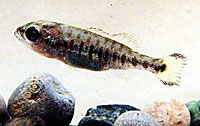
As smallie fry grow to an inch, they feed on progressively larger food items. Large fry effectively capture small insect larvae and even an occasional small fish fry. Zooplankton, insect larvae and more and more fish fry comprise the diet of smallies from 1" to 2". These fingerlings quickly progress to a diet dominated by insect larvae and more and more fish fry. I fed small 3/4" to I" minnows and shiners to the 2.0" to 2.5" smallies used for pictures in this article.
If a pond regularly has lots of newly hatched minnows in early summer, the smallies at a smaller size will begin to feed on hatchling minnows. In some habitats lacking abundant baitfish or when baitfish are scarce, then crayfish and large insects can be a significant part of smallie diet, even to sizes of 19" long.
If insect larvae and small fish are not abundant in the pond, fingerlings resort to eating zooplankton and small invertebrates indefinitely. This feeding lifestyle is what often happens in instances where fingerling smallies are only 2"-3" long by late fall. Young smallies will feed almost continuously, day and night, and with ample food can grow as much as I mm per day which will result in 6" to 8" of growth by late fall of their first year.
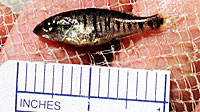
Sometime during their first year, when smallies are normally about 4" long, they gradually shift from feeding high off the bottom to close to the bottom. The dietary shift is from feeding primarily on zooplankton and small suspended insect larvae to areas dominated by fish and tiny crayfish. Young crayfish, about 1" long, enter the food web in early summer. Several studies indicate tiny crayfish become part of the diet once smallies reach about 3" long. This is where expanses of large rock areas on the bottom with some nearby vegetation provide good refuge and optimum feeding areas for crayfish, small minnows, and fingerling smallmouth.
Smallies at 5"-7" long regularly feed on cray-fish, if available. Smallies are fairly adaptable to developing food webs. As juveniles, smallies remain primarily as consumers of invertebrates or switch to eating mostly crayfish and fish depending on which foods are most abundant. When crayfish are available, they will be a large part of the smallie diet. If you are planning to raise smallies it is a good idea to create good rocky habitat, stock crayfish, and your smallies will be happy.
When growth is slow and food reserves low toward the end of the first year, fingerlings will have high mortality rates during the high-stress period of winter.
Stocking
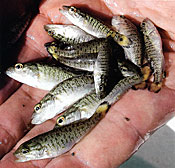
For stocking new ponds with smallies, I usually follow the philosophy noted in Eric West's May-June 2009 Pond Boss science review article titled "Key is Manageable Population Densities and Food Supply". Eric noted recent research shows that for predator-prey balances in small ponds, predator's food demand easily and often exceeds prey supply. This results in reduced growth of predators. Trophy-sized fish rarely occur in these ponds where all too frequently, too many predators are present with inadequate forage supplies. This out-of-balance situation is recognizable because the pond owner has to regularly add forage fish or reduce the numbers of predators.

Some innovative fishery managers are now having good success producing fast growing trophy-sized fish by initially stocking fewer predators per acre after allowing a summer or a full year for the pond to develop a large forage supply. For forage and food item stockings, I suggest you stock appropriate types of forage species at the same numbers used for producing a largemouth bass fishery.
When stocking ponds with fingerling smallies, I suggest adding 50 to 60 fingerlings per acre AFTER the pond has had several months to a year to develop a full complement of forage fish and numerous types of invertebrates. I have had good success with stocking as few as 30 smallies per acre. Newly introduced smallies will now grow like gang busters if the forage fish have had a chance to produce high numbers of breeding adults that can better maintain the backbone of the food supply for the ever-increasing sizes and numbers of smallies. Waiting a year to stock predators also gives the pond ecosystem some time to mature which naturally enhances various aspects of the habitat. Enhanced habitat always grows better fish.
Compatible Fish

Other species of fish that display various forms of competition negative to smallies are bluegill, green sunfish, tilapia, channel catfish, bullheads, and gizzard shad. Want bluegill with smallmouth bass? Then I think it is best to use just male bluegill with smallies. See Pond Boss magazine Mar-Apr 2006 for growing male bluegills. I have found long-term success rarely occurs with bluegill as the main forage for smallies. In a few rare cases, smallies can survive with bluegill as forage fish but be very thoughtful when trying this concept. Intensive, hands-on management will need to occur and no weeds should be allowed to grow in the pond. Bluegill can and will easily overpopulate a pond designed and managed for smallies.
Fish I have found acceptable to combine with smallies are non-reproducing predators such as hybrid striped bass and walleye. Acceptable panfish are yellow perch and redear sunfish. Redear sunfish, in spite of their spiny fins and poor forage fish body shape for smallies, produce few young per year compared to bluegill. This tends to significantly reduce the chance of panfish overpopulation in a smallie pond.

I have experience with a redear sunfish-yellow perch-smallie combination in several ponds. It seems to be acceptable. A few Pond Boss forum members are also trying redears, yellow perch, golden shiners and minnows with smallies. Don't forget to add a few crayfish. Early reports are these fisheries are prospering and smallie spawns Good forage fish for the smallie pond are fathead minnows and golden shiners. Lake chubsuckers also were found to be a good, sustainable, soft rayed forage fish for smallies (Bennett & Childers 1972). Lake chubsuckers are now being raised at several hatcheries around the nation. In southern ponds, another possible forage fish with smallies is threadfin shad, although I have no personal experience with this combination. I suspect threadfin shad reproduction could outpace predation by the smallies.
Whenever I have put smallies in a pond designed primarily for the pond owner's swimming recreation, I usually stock smallies by themselves with no forage fish, or with some soft-rayed forage fish and crayfish. In these ponds, smallies don't grow real large but they have always spawned successfully and thrived. Dr. Dave Willis (South Dakota State University), others and I have had good success raising smallmouth alone or in combination with just soft-rayed forage fish as various minnows and shiners (Buck & Thoits 1970). Always consider adding crayfish wherever you stock smallies.
I think the most important factor for producing good smallies is to keep largemouth bass out of the pond. The second most important item is that high water temperatures are not as detrimental as reduced water quality. For success, aerate the pond and minimize turbidity.
The more closely you follow my guidelines in these articles, the better your smallies will develop and grow for you. The fifth and final article in this series will deal with growing and managing your smallmouth bass-based fishery.
Reprinted with permission from Pond Boss Magazine

